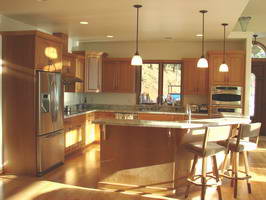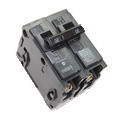Upgrading Home Electrical Wiring for Safety
 '; ';
|
How Can I Fix a Voltage Problem in my Electrical Wiring? Don’t Take a Chance With Old Home Electrical Wiring, How to Update Old Home Wiring To Current NEC Codes. © By: Dave Rongey |
Electrical Wiring Problem
Electrical Question: How Can I Fix a Voltage Problem in my Electrical Wiring?
I’m moving into a new apartment on the second story of a 3 story Victorian house that is approx 110 years old. The electrical supply box is relatively new which was installed when the landlord made the move to install 220v baseboard heaters. I haven’t been able to figure out how the original wiring is run in most of the apartment. I have a 100A main, two 20amp dual pole breakers, two 15a, a dual pole independent 20a breaker and a 30a breaker all located in the basement. There is also a fuse box with two 15a time delay fuses.
My Electrical Project
- I wanted to install a new GFCI outlet in the bathroom along with a switch for the light fixture. The fixture is above the sink with a black spinning switch about 6′ off the floor. I installed Wiremold tracks from the fixture to a new box where I installed a GFCI plug and a illuminated switch. The GFCI will not energize at all. The system is old aluminum wiring and I found there is ground in the boxes and I get 120v across hot and ground.
- I also noticed that in the switched outlets I still get a 20v charge when the power is off.
Thinking there may be some leaking current in the old switch, I replaced one of the switches with a new switch and still get this 20v charge in the off position. Most of the exposed wire I have seen in the boxes has insulation that is pretty badly eroded and very brittle. I can only assume the problem follows all through the conduit. - Is there a fix for the leaky voltage and getting my GFCI to work?
I would even install a GFCI breaker in the panel if that would work. I just think that if there is a voltage leak in the branch the breaker would also stay tripped as well. - Is this condition a hazard?
I’m sure that the wiring in the rest of the building is in the same state if it hasn’t been recently replaced. I have a few years of point to point wiring and wiring panels via schematics but I’m not an electrician. Is my land loard going to have to call in the pros to keep the place from meltdown?
This electrical question came from: Stosh, from North Wales, Pennsylvania.
Dave’s Reply:
Thanks for your electrical question Stosh.
Fix Voltage Problems by Upgrading the Electrical Wiring
Don’t Take a Chance With Old Home Electrical Wiring
- Updating the Electrical Wiring of an Older Home will make any home safer, and I would strongly suggest that the electrical system have a full safety evaluation starting with the grounding system at the main electrical service panel.
- Voltage Leaks and Electrical Hazards
If there is a problem with the grounding system then this can contribute to voltage leaks which can feed back through the electrical system causing dangerous conditions including the possibility of shack hazards.
Bringing Old Home Wiring Up To Code
- As a tenant, it would be in your best interest to advise the landlord about the voltage leaks that you are experiencing because this can be harmful to you and your family until the problem is identified and resolved.
- After an electrical safety evaluation has been made then the owner should take the information and obtain bids from local Licensed Electrical Contractors to have the electrical problems corrected and then proceed with any suggested upgrades and corrections.
- I would strongly advise having the basic electrical safety items installed that will help protect you and your family, such as GFCI protection and Smoke Detectors as required.
More about Upgrading Electrical Wiring
- Electrical Codes for Home Wiring
- Electrician Explains Home Electrical Wiring Codes including AFCI Circuit, Junction Boxes, Electrical Circuits, Codes for Outlets, GFCI Codes, Electrical Service Panels, House Wiring, Lighting Codes, Codes for Smoke Detectors.
Electrical Codes For Home Wiring
Wiring Electrical Outlets for the Home
Home electrical wiring includes 110 volt outlets and 220 volt outlets and receptacles which are common place in every home. See how wiring electrical outlets for the home are done.
Wiring a Light Switch – Diagram 1
Fully Explained Light Switch Wiring Diagrams. Detailed Electrical Wiring Diagrams and Pictures assist your Home Electrical Projects.
House Wiring Circuits and Circuit Breakers
This article looks at common 120 volt and 240 volt house wiring circuits and the circuit breakers that are installed identifying the types and amperage sizes used in most homes.
Home Electrical Circuit Breakers
A guide to home electrical circuit breakers and how they work to protect your electrical wiring. When properly installed, your home electrical wiring is protected by a circuit protection device.
Electrical Wire for the Home
Complete listing of electrical wire types and parts used for home projects with electrical code information serves as selection guidelines.
Home Electrical Junction Boxes
Electrical Junction Boxes for Home Wiring
Understanding electrical junction boxes and what they are used for. Home electrical wiring is the process of installing electrical wire to a location that will serve electrical devices or an appliance. One very important component is the box where the wire will be installed. The type and size of the home wiring electrical boxes will depend upon the circuit size, application and its location.
Wiring GFI Outlets
GFCI and GFI Wiring Diagrams
GFCI Wiring
This list of articles will help you learn about the features and benefits provided by GFI and GFCI Receptacles and how they are wired.
The following may also be helpful for you:
|
|
Be Careful and Be Safe - Never Work on Energized Circuits!
Consult your Local Building Department about Permits and Inspections for all Electric Wiring Projects.
More articles about Electrical Wiring, wiring upgrade and Home Electrical Wiring: |
|
| « Previous | Next » |
My Voltage Seems Normal but the Outlet Will Not Work |
Electric Circuit for an Arc Welder |



















